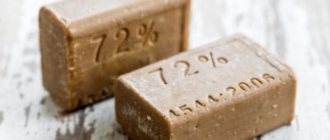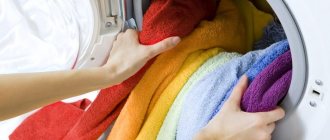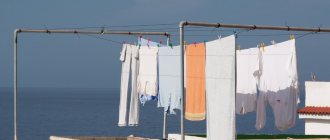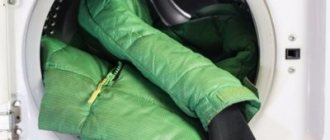Types of washing systems for automatic machines of the 21st century
Additional systems and functions of modern washing machines
What is modern spin?
Does the machine weigh the laundry itself?
A little about prices, or What you need to know when choosing a brand of washing machine?
Does it make sense to buy more?
Operation of the washing machine according to EEC criteria
Selection results
Types of washing systems for automatic machines of the 21st century
Air bubble (shower jet).
Through special holes in the drum, streams of water saturated with oxygen enter it. Passing through the fibers of the fabric, these air bubbles remove dirt from there.
Combiwash.
This system combines the treatment of laundry with complete immersion and a more delicate wash under streams of water pouring from above.
Shower system.
With this system, the laundry is sprayed from above with detergent solution in addition to being treated with it at the bottom of the drum.
Jet System.
This is the name of a system that involves supplying a washing solution to the drum under high pressure.
Direct Spray.
The operation of this system is based on a constant supply (injection) of a detergent solution. The pump pumps it up and feeds it into the drum under pressure. Water passes through things and is again taken from below by a pump. It turns out that during the washing process, things are treated as if with a water shower.
Activa.
This washing system delivers a powerful jet of water into the drum. The required volume of liquid enters there in approximately one minute, which ensures very fast initial processing of things.
3D Aqua Tronic (3-DAqua-Tronic).
Asymmetrical grips make it possible to humidify water from behind and from above. This system makes it possible to remove dirt from things in a short time.
3D Aqua Spar (3-DAquaSpar).
In this system, water is supplied from three sides: there are holes in the drum, from where it enters it from above and through the back wall. Aqua Tronic. The asymmetrical grips present in the drum take a certain amount of water to the top, so the laundry is irrigated from above, and not just in the water at the bottom of the drum.
Aqua Spar.
There are asymmetrical grips on the drum, with which water is carried upward during washing, and in a fairly large volume. It turns out that things are not just immersed in water, but are also irrigated from the top wall.
Traditional.
In order for the laundry to be washed, water enters a container that contains a rotating drum. Contact of laundry with the detergent solution occurs at the bottom of the drum.
How to check the tachogenerator
The reason for the incorrect operation of the tachometer can be not only an internal malfunction of the sensor itself, but also a defect in the wiring or fixation of system elements (the coil itself or a magnet rotating on the motor shaft). And if to diagnose the first case it is necessary to remove the electric motor, then for the second and third cases a visual inspection will be sufficient.
As a rule, the Hall sensor is quite reliable in operation, but sometimes it also fails. However, it is not always necessary to remove it from the engine, and the engine from the machine. To check the correct operation of the sensor, you must:
- remove the back panel of the washing machine by unscrewing the fasteners around the perimeter;
- slowly turning the engine pulley, release it from the drive belt;
- disconnect the wires coming to the electric motor (do not forget to mark them or photograph them in the mounted state, so that during reassembly you can restore the connection correctly);
- release the tachometer contacts from the common bundle of wires;
- use a multimeter in resistance measurement mode to take readings from the sensor contacts (the norm for it at rest is 60-70 Ohms);
- Use a multimeter in voltage measurement mode to take readings while rotating the motor by hand (readings will be within 0.2 V).
If the multimeter readings on the tachogenerator contacts are within normal limits, the cause of the malfunction should be looked for in something else: the sensor fastening, the sensor rotor fastening, the reliability of the wiring connection, its integrity, condition, etc.
Additional systems and functions of modern washing machines
Start timer
— using this device you can delay the start of the wash for a period of 1 to 24 hours. The presence of a timer is convenient for users using a two-tariff electricity payment system, because gives them the opportunity to save money through cheaper overnight washes.
Water stop
- a function that prevents wrinkles of clothes that the user does not intend to remove from the washing machine immediately after washing. The machine is stopped without draining the water.
Spin at intervals
- a special spin, during which there is a gradual increase in drum rotation speed at each stage of the cycle. The system makes a long interval between its individual phases. Due to this, the total duration of the spin cycle increases, but the clothes after it have almost no wrinkles.
Anti-crease
— at the end of the wash there is a special phase during which the drum rotates at a speed of 30 revolutions per minute. During it, the underwear makes smooth movements back and forth, as if swaying.
Hatch protection
— due to this system, the loading hatch is blocked during the wash, as well as after its completion for 1-3 minutes. This is done to ensure that users do not get burned or injured, because during washing a number of machine parts are subject to intense heat.
Drainage
— with this system, water is drained from the machine without rotating the drum.
More water
— this function provides a larger volume of liquid for better washing of clothes.
Automatic water cooling before draining
— this system lowers the temperature of the water drained from the machine. This is done to ensure that there are no temperature changes in the drainage system.
Automatic cost optimization
- a system that allows you to reduce costs due to optimal consumption of electricity and water, determined by the load volume.
Automatic balancing
- a system that controls drum speed during spinning. If there is an imbalance, the engine stops, which then begins to operate in reverse rotation mode, i.e. the drum rotates alternately in different directions. This is necessary to ensure that the laundry is distributed evenly. If the balance is unattainable, the engine runs again, but at lower speeds. Also, thanks to this system, the stability of the washing machine is ensured, and the service life of its components is extended.
Smart system
monitors foam formation and determines the number of spin revolutions depending on a particular type of item.
S-system
controls foam formation. A special sensor checks the amount of foam formed during spinning and draining. If there is too much of it, the operating time of the drain pump, which pumps out the foam, increases.
Fuzzi Logic
is a system that monitors parameters and operating modes. At the very beginning, a little water enters the drum, which is rotated several times so that the moisture is absorbed into the laundry. Electronics calculates how much laundry needs to be washed and determines the amount of water required for this. In addition, it checks what temperature the tap water is and, in connection with this, determines the duration of the wash, setting aside the time required for the water to reach the required temperature. When this data is processed, thanks to the system, exactly as much water enters the machine as it considers necessary. During the rinsing and spinning process, Fuzzi Logic's competence includes control over the number and duration of cycles, drum speed, etc.
Fuzzi Control
— a service system that monitors and corrects the washing program depending on how much laundry and what type is in the machine; it also regulates the water consumption during rinsing. If she “sees” that foam is being formed in excess, then she starts an additional rinse, changing the rhythm of the drum rotation if such a need arises. During the spin cycle, the system monitors the imbalance and sets a mode in which the laundry is constantly spinned at the highest possible speed.
Booble-soaking
- a system that dissolves detergent in a special way. It dissolves completely, 100% due to the fact that the water is enriched with oxygen bubbles.
Aqua Stop
- a system that neutralizes water leaks. If a leak starts in any part of the washing machine, the system detects this and turns off the water automatically.
Aqua Sensor
- this is the name of the device, thanks to which the water consumption varies during washing. If it is not clear enough, the volume of liquid increases, as does the duration of rinses. If the device is completely “satisfied” with the transparency, then it reduces the number of rinses and their duration.
ALC system
— automatic water control. This system adjusts the energy and water consumption to the load size and type of laundry.
How to choose a washing machine with additional laundry
The correct choice of a washing machine with the ability to reload items depends on several factors:
- Loading volume and dimensions . When purchasing, you need to take into account that the stated dimensions may be smaller than the actual ones; they do not take into account the protruding parts of the case.
- Type: frontal or vertical . When used, front ones need a larger area, vertical ones need free space at the top.
- Reloading method . For vertical and front type machines it is different and is carried out either through the main hatch, which will pause the cycle, or through a special window.
- Functionality . It includes the number and type of programs, the presence of manual adjustments. The choice depends solely on your needs, but models with a wide range of modes are universal - you can wash any clothes, blankets, outerwear, toys in them.
What is modern spin?
Spin is a program that removes moisture from the laundry, as well as any remaining detergent. At this stage of processing things, the drum rotates rapidly, centrifugal force forces the water to leave the laundry, and there it is “picked up” by a pump, which removes it from the washing machine. The rotation speed may vary depending on the machine model. The lower it is, the more the laundry remains damp after treatment. The spin phase is usually included in any washing program (very delicate washing is an exception). But it is possible to set the spin cycle separately if, for example, you need to spin clothes that were previously washed by hand.
400 rpm - this spin is considered the weakest, practically the same as a hand push. It is used for things made of thin, very delicate fabrics.
500 rpm - this spin is already stronger, but is also considered weak and is also used for thin, delicate items.
600 rpm - this spin is called intensive and is used for spinning items made of delicate materials.
800 rpm – spin with greater intensity. It is used to twist things made from cotton and synthetic materials.
1000 rpm - this high spin speed is used to process coarse fabrics.
1200 and more - spin at these speeds is considered very strong and is used mainly for terry fabric.
Which washing machine to choose
It is easier to purchase a good washing machine if you take into account all the main selection factors. To a greater extent they relate to the technical part. Quality and reliability depend on the manufacturer, so it is better to buy a device from a well-known brand. Famous brands provide customers with service, warranty and technical support, which is very important when using any devices.
The rating from our editors will help you weed out unsuccessful models and choose the best washing machine with additional loading, wide functionality and decent quality.
Does the machine weigh the laundry itself?
Using systems that control the water level, which are equipped with many washing machines, allows you to save powder and other detergents, and such savings can reach 20-30 percent. Such systems do not allow you to “waste” water; they collect as much of it as you need. And the less water is required for washing, the less electricity is spent on heating and the less powder is required for high-quality washing of things. The washing machine saves water using the following scheme. If, for example, you need to wash cotton laundry, then this should be done on a program for washing coarse laundry. The machine pours water on its own, while the drum rotates from time to time, which leads to natural wetting of the laundry. After it is completely wet, water begins to accumulate in the drum, no longer being absorbed into things, and excess water is formed. As soon as the water level reaches a certain limit, the sensor will work and it will stop flowing into the machine. Some sellers of household appliances call the use of such water control systems a laundry weighing function, but such a comparison can only be conditional.
Maximum for loading
Modern washing machines can have a maximum load of laundry from 4 to 12 kg. These are quite large values, since the weight of one standard bedding set is only slightly more than 1 kg. Accordingly, several such sets can be placed into the device at a time. All these are only theoretical calculations, but in reality the results can differ significantly, since not only the amount of laundry matters, but also the type of material, as well as its condition.
Washing machine with modes Source o-vannoy.ru
Manufacturers indicate in the instructions and on the machine body the maximum possible drum load, based on the characteristics of the device’s engine. During operation, equipment should move things inside freely and not experience excessive stress. This limitation was created to protect the engine from damage, so it is extremely important not to exceed the specified parameters.
The maximum weight of laundry for washing is always noted in dry form, since it is very difficult to weigh and place wet items in the drum. This number usually applies specifically to cotton products, and other fabrics may vary slightly in weight. It is not at all necessary to pawn the maximum possible number of things each time, and this is not necessary. Excessively dense placement of laundry can impair the quality of the wash and lead to gradual wear of the machine engine.
Washing machine with control panel Source cosmo-frost.ru
A little about prices, or What you need to know when choosing a brand of washing machine?
Most recommendations for choosing a washing machine boil down to the fact that it is necessary to carefully study the washing class, various functions, sizes, load volumes, the presence of protection against leaks and other parameters - significant and not so significant. To one degree or another, all these characteristics determine the choice of a future washing machine. However, it makes sense to dwell in more detail on this criterion, which for many is almost decisive, namely the cost of the washing machine. We will also consider the price segment in which well-known manufacturing companies operate.
Agree, it is pointless to dream of any fancy units, fashionable “tricks” that are equipped with expensive cars, if the purchase budget is limited to, say, 300 dollars. Therefore, it is the amount that you are willing to pay for a home assistant that you should start from first of all. Many parameters play an important role, but it is quite clear that you will have to pay money for useful functions. If inexpensive machines, for example Indesit or Samsung for 8,000 rubles, worked with laundry better than anyone else, then they would become super-hits of sales, and people would buy them, who could be generous with more expensive equipment. But on various forums where the quality of work is discussed, such machines, unfortunately, very often contain negative reviews.
Does it make sense to buy more?
Is buying an expensive washing machine worth it? As a rule, such a washing machine can work for a decade and a half. At the same time, it can save about a third of washing powder, water, and electricity compared to less economical models. If you base your laundry on twice a week, you can save about two to three hundred dollars on laundry detergent alone. In addition, you need to take into account that expensive machines treat laundry very delicately, which extends the life of things and is also, albeit indirectly, a saving. Accordingly, it still makes sense to pay $300-400 more for a washing machine than for cheaper units.
A washing machine is a product that, like every product, has its own “representative” copies and something that can be compared with consumer goods. There are Lincolns here, and there are also Zaporozhets, and it’s not entirely correct to compare these machines: each of them exists for specific needs, for its own category of buyers, and if a person buys this or that washing machine, it means he needs exactly like this.
In terms of cost, washing machines can be divided into three price categories - high, medium and low. As for the lower level, the task of manufacturers is to make a washing machine that is simple in function and control, inexpensive, but at the same time quite convenient. As a rule, in this segment the average price for a washing machine is less than 350, and sometimes even 300 dollars. This segment is represented mainly by brands such as Indesit, LG, Samsung, Candy, Ardo, Beko, Siltal, Ariston. Despite the differences between them, there are also similarities - and this is a rather modest functional equipment. There are not too many washing programs in them, and manufacturers are trying to reduce the cost of such units by using not high-quality parts, but components of average and even low quality. All this cannot but affect the reduction in service life, which in this case is no more than 4-5 years. If some cars managed to last longer, then this is rather an exception that confirms the rule. In addition, if washing machines of previous generations, for example, Indesit, assembled in Italy, still had a chance to withstand more than a dozen years of operation, then for machines produced today such a service life is something out of the ordinary and virtually unrealistic.
The more expensive segment is represented by the brands Electrolux, Bosch, Kaiser, Whirlpool, Siemens, Gorenje, Zanussi. Here, the average washing machine will cost $400-600. Five years of operation is far from the limit for these washing machines; they can easily last 7-9 years. There are many more programs here, washing has improved parameters, some additional functions are provided that make operation more convenient, for example, anti-crease protection, aquastop, etc. The great prestige of these brands also plays a role, which becomes especially significant and pleasant when friends use cars from the same price segment.
In the higher price category the choice is much more modest. Here you can remember Miele, Aeg, as well as Maytag, Amana, GE, Frigidaire - American-style laundry complexes. If we compare representatives of this category with machines of the first and second, the difference in the quality of washing, care for things and comfort of use turns out to be very significant. This can be seen in illustrative examples: in order to show the capabilities of the Aeg washing machine, at the presentation a large bouquet of roses is placed in it, after which the wash is started at 1600 rpm. When the flowers are taken out from there, the admiring audience gasps, because they have not lost their appearance at all, but have only become fresher. It’s not hard to imagine what would happen to the roses if they were washed in a machine from the first and second groups. Of course, for such quality you will have to pay significantly more - from 800 to 2000 dollars. Such washing machines cannot be said to work forever, but they can easily withstand a decade or a year and a half. On the forums you can find statements from happy owners of Miele machines with 30 years of experience in their successful operation, and this may well be true, provided proper care and maintenance, because the machine belongs to the luxury class.
Left outside the scope of our classification are professional washing machines, which are used in laundries and cost in the range of 900-3000, and not dollars, but euros. They can easily withstand 10-15 washes every day. So, the highest level is represented by American brands, as well as Miele and AEG. The middle link is the “pyramids” - Electrolux, Kaiser, Whirlpool, Bosch, Siemens, Gorenje. The transition link to the lowest category is Zanussi. This level is represented by LG, Beko, Ariston, Samsung, Indesit, Ardo, Siltal, Candy. However, the above-mentioned manufacturers do not necessarily produce cars strictly within a particular price category. You can find some Bosch models that cost over $1,000, and Samsung has units for $500. And yet you need to understand that these manufacturers have developed their main specialization over the years, that is, Bosch belongs to the middle price segment, and Samsung and Indesit belong to the lower price segment. Don’t be confused by the choice between, say, a Bosch model for $1,200 and a Miele or Aeg for $1,000-1,500, because these are completely different things. Therefore, if you are aiming, for example, at a middle-class unit, look among companies specializing in such products.
Electrolux Calima EWFM 14480W
The washing machine with auto-weighing from Electrolux is also not far behind. It also reads the weight of the laundry loaded into the drum, evaluates the nature of the existing stains and displays the most suitable program. The “trick” of the model is the Time Manager function, which allows the program to change the time on the selected system at its own discretion, speeding up or slowing down the engine. Thanks to this feature, washing machine owners receive optimal washing duration, high-quality results, as well as economical consumption of water, detergents and electricity.
In addition to convenient intelligent control, this front camera guarantees complete protection against leaks, 15 standard programs and child locking of the panel. The machine also boasts a drying board on the top panel, which is suitable for both synthetic and delicate fabrics. The capacity of the drum is 7 kg of dry laundry with a compact size with a depth of 60 cm. The cost of the model starts from 26,845 rubles.
Interesting:
- How much powder should I put in the washing machine?
- How does the pressure switch of a washing machine work?
- Fuzzy logic function in a washing machine
- How much does a dishwasher weigh?
- Comparison of technical characteristics of washing machines
- Gorenje washing machine error codes
Reader comments
- Share your opinion - leave a comment
Operation of the washing machine according to EEC criteria
In Europe, since the beginning of 1995, the so-called EEC criteria that allow you to objectively compare different models of washing machines. They are based on certain technical characteristics and are recorded in a single rating scale. Inside each washing machine you can find a special insert that contains the relevant information (see picture).
1. Energy consumption class. There are 7 of them - from A to G, and they depend on the level of power consumption.
2. The figures indicated in this section indicate how many kW/h this washing machine consumes for washing at 60 degrees (one cycle, processing coarse laundry).
3. Washing efficiency by class, also from A to G.
4. Spin efficiency is indicated in a similar way, i.e. letters from A to G, with classes C and D considered optimal. Spin efficiency is the number of drum revolutions per minute - the main, but not the only characteristic that determines the final degree of humidity of things after the spin procedure is completed. This parameter will be influenced by its duration, as well as the diameter of the drum. At the same speed, the best spin is demonstrated by a machine with a larger diameter. If we compare models with the same drums and spin speeds, then a washing machine that takes longer to spin will do a better job with laundry. If we are talking about more than 1000 revolutions, then it should be taken into account that usually things are spun at only 900, and the maximum number of rotations is provided only at the very end of this phase of laundry processing. If the machine is a budget machine, then at the fastest speed it spins for only 30 seconds, expensive washing machines devote 2 minutes to this, and the most expensive ones - 4 minutes. All these parameters are relative, for example, the spin speed of the domestically produced Siberia washing machine is 2700 rpm, but the centrifuge has a very modest diameter. Thus, when choosing a washing machine, it is advisable to pay attention not so much to the spin speed, but to the residual degree of moisture in the laundry.
5. Maximum possible load in kilograms. In this case we are talking about linen made from coarse fabrics.
6. A very important criterion is water consumption per wash. The less it is needed, the less money you will have to spend on paying for electricity and purchasing detergents.
7. Noise level - both during washing and during the spin process. Measured in decibels and often not indicated. Today, the best indicator is 43 dB - with this noise level a machine of the brand OKO-LAVAMAT 86800 brand AEG washes. SIEMENS WM 71630 washes with a noise level of 47 dB, ASKO 12605 machine -55 dB. The operation of the above models is considered very quiet.
Gorenje Premium Touch WA 65205
With Gorenje Premium Touch WA 65205 you can find out what real weighing of laundry is like before washing. It is enough to load the drum and turn on the machine, after which the system will calculate the kg and offer the user the optimal washing program . The ideal selection of cycle duration, temperature and spin force is guaranteed by special sensors and UseLogic electronic intelligence. This technology allows you to collect and analyze information about the type of fabric and the nature of contamination, as well as ensure the minimum required consumption of water and electricity.
On Gorenje Premium Touch WA 65205 you can save the selected mode and use it if necessary.
The machine is controlled via a liquid crystal display, and all programs and commands are displayed in Russian. Information about the water heating temperature, spin speed, remaining washing time and liters and kW/h consumed is also displayed here. There is a cycle sound, as well as a delayed start for 24 hours, foam control, auto-dosing, and child lock. Safety is ensured by numerous sensors that record the degree of overheating, overflow and leakage.
In addition to the above, the machine offers 29 programs along with the option of “easy ironing”. The capacity of the model is 6 kg, dimensions are 60/85/59 cm. The unit costs about 45,520 rubles.











